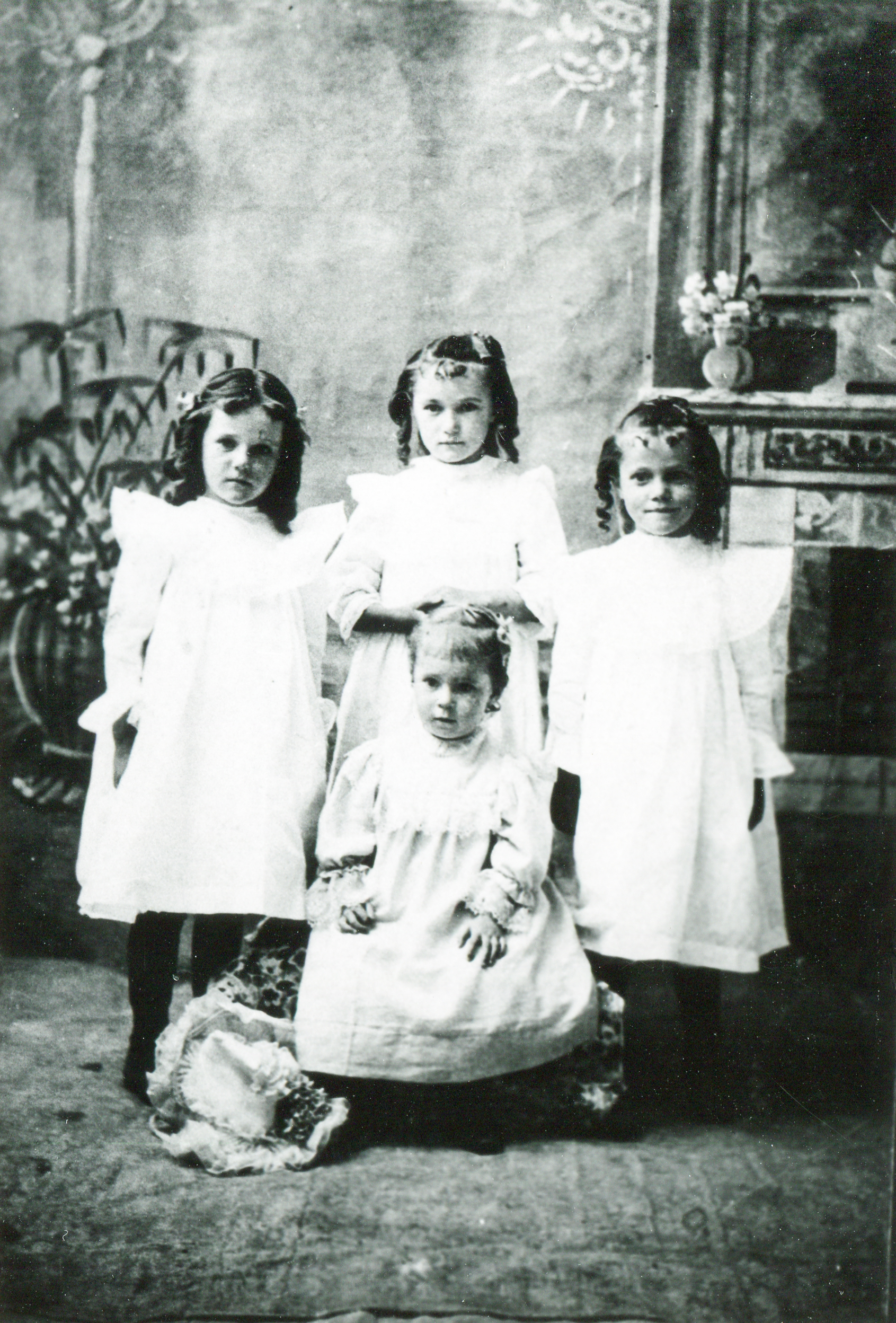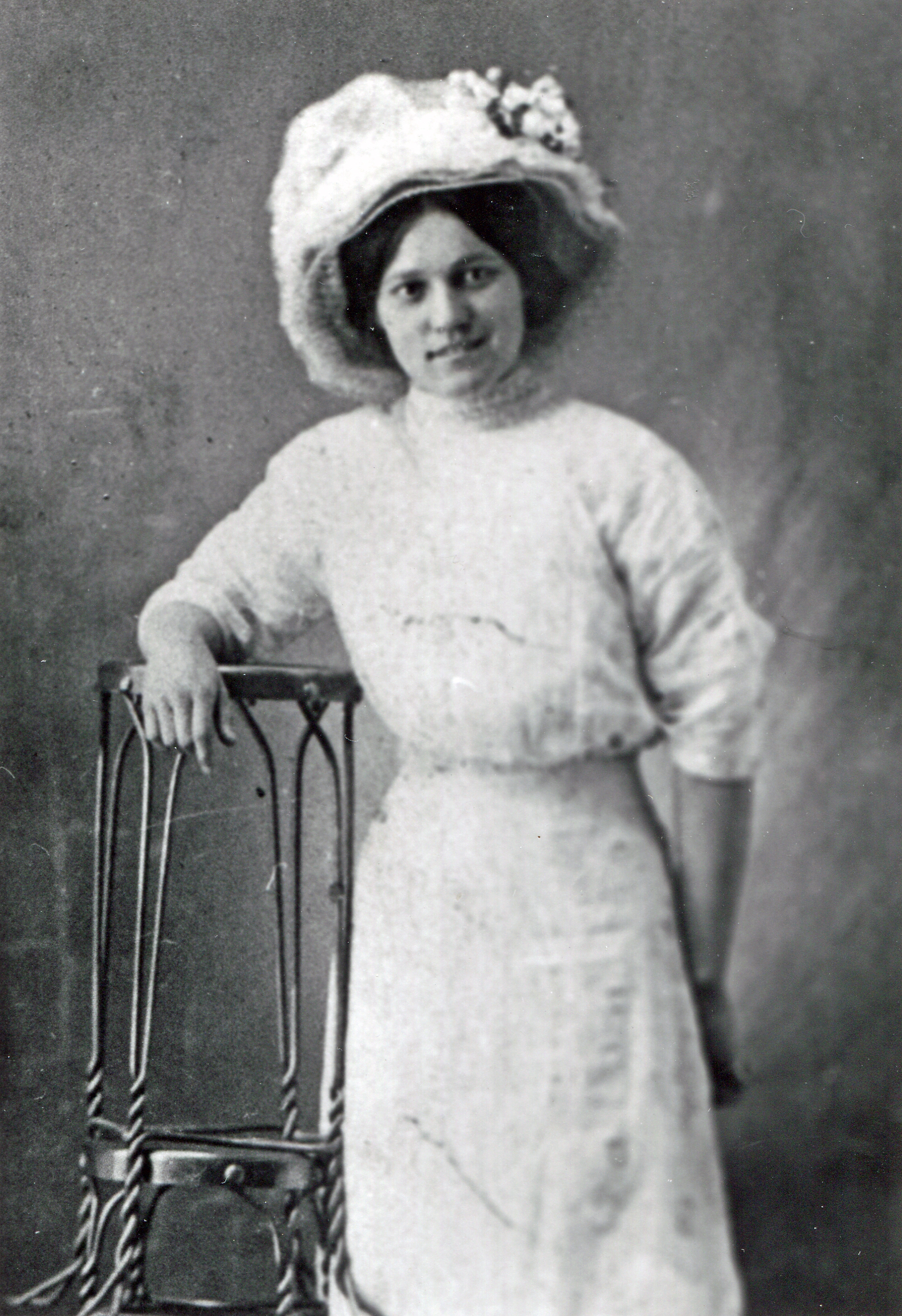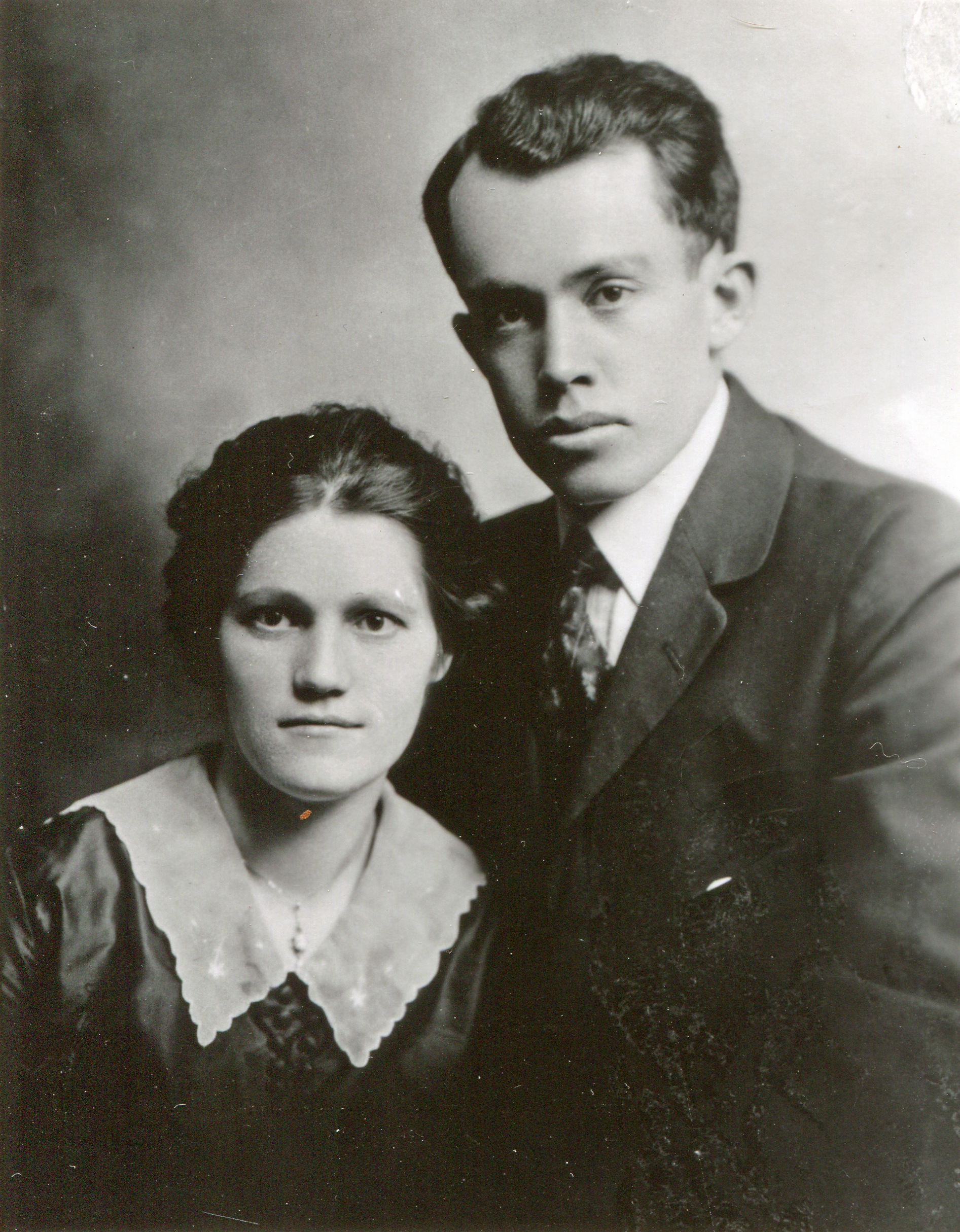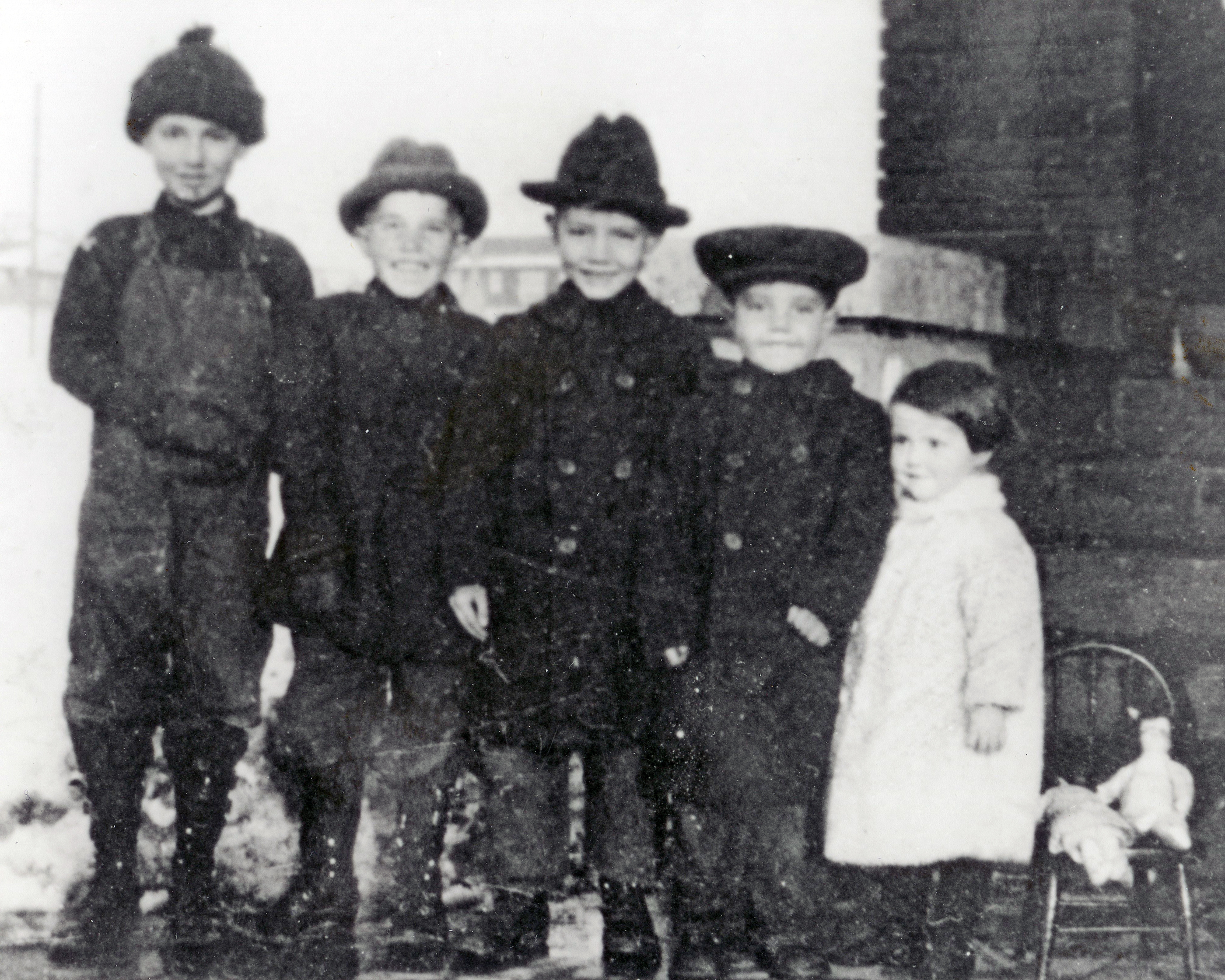Photos
Right-click [Mac Control-click] to open full-size image:

Ione, Alberta, Irene and Vilate (seated)

Irene Perkins

Irene and Edward Lyman

Children of Edward and Irene about time of Allie's birth
Irene Perkins
Birth: 11 March 1894 at Bluff, San Juan, Utah, USA
Parents: Benjamin Perkins and Sarah Williams
Married: Edward Partridge Lyman 12 February 1913 at Salt Lake City, Salt Lake, Utah, USA
Death: 24 May 1968 at Blanding, San Juan, Utah, USA
LIFE SKETCH OF IRENE PERKINS LYMAN
Tiny little twin girls arrived March 11, 1894, at the two-room log cabin home of Sarah and Benjamin Perkins in Bluff, Utah. To the older children in the family, it seemed like a miracle had happened, when they returned home after spending the day with relatives and found two little bundles of babies.
The twins together barely weighed five pounds. How could they be cared for...what means used to keep warmth and life in those little bodies...how could they be fed? There were no incubators in which to place them, no medical skill to call on, no conveniences whatsoever in Bluff in those days.
But those people were pioneers and through their faith and ingenuity always found ways to meet new and strange situations. Two wicker baskets with handles that could be used to carry them, were lined with a baby blanket, then a thick layer of cotton batting, the babes wrapped in diapers then in cotton and placed in the baskets with flasks of warm water placed around them.
That water was carried from a well about a block away then heated on a wood burning stove. It had to be kept warm 24 hours a day. A good part of the time the little hearts failed to function properly causing the babies to have spasms, from which it seemed they could not recover. Many times they were pronounced dead and the minutes seemed hours before they showed signs of life. But through constant vigilance, faith, prayer, and the power of the priesthood, they lived through it. It was months before they could even be dressed.
Aunt Jody Wood was the “doctor”. She was astonished and almost dismayed with the twins arrived. “Aunt Jody” was not a professionally trained doctor. She was a woman who had been called and set apart by the priesthood to fill this position. Everyone loved her very much, and she was a very capable woman.
These babies were given the names of Irene and Ione. Mary Ellen, Beatrice Ann, Sarah Elizabeth, Gladys, and Richard Leonard preceded the twins. When Ione was about three years old, scarlet fever was contracted and each one of the family had a siege of it, even to Alberta, who had joined the family when the twins were only 18 months old. The family was in quarantine for 13 weeks.
A little later on the twins had a relapse, complications set in, and again their lives almost despaired of, especially Ione. She had brain fever they said. Brother Platte D. Lyman was called in to administer to her and he told her mother that sometimes after long spells of such high fevers a person's brain might be permanently damaged and he advised releasing her to the Lord. Ione had such a pale little face and her big burning eyes and restless little hands picking at her ears till they were bleeding. So her hands were covered with mittens.
That siege of sickness passed, only to have a second relapse to both twins. A doctor came from Mancos, Colorado, and he said it was their kidneys, and unless they were taken to a hospital immediately, they could not live. How could that be, a hospital was a week away with team and wagon! A lady in Moab heard of their plight and sent word to their mother to steep watermelon seeds and give them the tea. Again the Lord was in charge and they lived!
The children were allowed to play away from home once a week, usually on a Saturday, and they had to be home by sundown. They spent a lot of times playing games such as “Hide and Go Seek”, “Steal Sticks” and “Run, Sheep, Run”. In the summertime they hoed corn and beans for neighbors to help the family finances. Irene recalls, “One year after Brother Peter Allan harvested his beans, I picked up enough beans to pay for a slate. We used slate and pencil a lot in those days. I divided my slate with my twin sister Ione as it was a double one put together like a book.”
The family enjoyed gathering wild sweet peas and climbing the hill where the cemetery was. On May Day the Primary, with the mothers and children, would ride up Cow Canyon or Calf Canyon and sometimes Sand Island down the river. They were wonderful trips.
For Christmas the children were glad if they got a few nuts and candy in their stockings, or, on rare occasions, a new hair ribbon, story book or an apple or an orange.
Irene related the time she and several of her sisters were hoeing weeds in a neighbor’s corn field. They had to cross a canal. Sadie got on one side and Gladys on the other. One would try to throw the younger girls across. They all made it except Irene, who landed in the middle of the canal. It was very swift and she nearly drowned before one of them caught Irene by the hair and dragged her out.
Irene also remembers when she and others were playing by the pig pen one day. One of her sisters dropped an apple she was eating and one of the pigs gulped it down. Irene called the pig a devil, and on hearing that, one of her sisters was so scandalized she ran to the house to tell their mother the awful word Irene had said.
One thing the girls all seemed to enjoy, partly because it gave a degree of enjoyment to their mother as well as themselves, was brushing Sarah's long, thick hair. One of Sarah's little pleasures in which she indulged herself was to have Irene sleep at her feet to keep them warm.
She went to help settle Blanding with her sister, Lell, and Albert R. Lyman, and was said to be Blanding's first baby sitter. While both she and Edward Lyman had lived in Bluff when she was a young child, she did not become acquainted with him until he returned from a mission. She married Edward P. Lyman on the 12th of February, 1913. They eventually had six children. The boys were DeAlton, Kay, Edward and Bob. The girls were Rene and Allie.
Edward began the Grayson Garage in Grayson/Blanding as automobiles were being introduced into the area. He sold his interest in the garage to his cousin, Marvin Lyman in the early 1920's. His farm became his full-time employment after the sale, where his mechanic skills were most handy. He became a fluent speaker of the Navajo language. He and Irene served among the Navajo people.
Grandson Arthur L. Morin related, "According to the stories I have heard, when grandma Lyman was born she was very tiny. I did not know until she had passed beyond mortality that much of her time on this earth was taken by illness or some other type of physical trial. But apparently she was quite spunky when she was young. A story told about her, one she heard and confirmed, was about a time a man approached her in the wrong way. She threw a fork at him and it stuck in his back. Though she was a no-nonsense person, not prone to joviality (perhaps an understatement), she was always nice to me. It was always great to visit grandpa and grandma Lyman and sleep in their silver trailer next to their small frame home."
Sources:
1. O'Brien, Alberta Lyman. The Story of Sarah Williams Perkins. Revised 1993. Download at
Internet Archive
2. Arthur Morin story found on FamilySearch
See also:
A Short Life Story of Irene Perkins Lyman and Edward
Partridge Lyman, 1987, by Mark Edward Lyman
Right-click [Mac Control-click] to open full-size image:

Ione, Alberta, Irene and Vilate (seated)

Irene Perkins

Irene and Edward Lyman

Children of Edward and Irene about time of Allie's birth